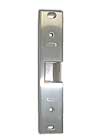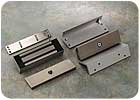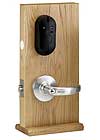
To install an electromagnetic lock, first a bracket is mounted where the lock is to go.
The options for electrical or electronic locking of doors usually operated by access control systems are varied, but limited many times by the use. Contributing factors are the door itself, the security system that already may be installed and the egress requirements in codes. The preferences of the customer or architect also may influence the decision.

2. Then the magnetic lock is slid on.
“We very rarely get the opportunity to request certain types of doors,†Cambria concedes. “Usually, the door is there, and we have to make it work with the door. A lot of times end users will know what type of locks they need to use.
“In our industry, a lot of the time what will happen is the construction of the building dictates the type of door or style of door, and it is up to the systems integrator to coordinate with the lock supplier what is the correct application for the lock in front of us,†he relates. “From there, it’s basically paying attention to electrical codes and life safety laws.â€
Security dealer Jim Tinder, owner of TinderCo, Indianapolis, agrees that the type of electrical or electronic locking system used depends largely on the applicable codes.

3. Tightening is all that is required to complete the magnetic lock installation.
“See what their needs are – automatic locking at certain times of the day?†Tinder continues. “How many people do they want to have access? What kind of data trail are they going to need, such as a tie-in with time and attendance? Do they want automatic locking at 6 p.m. and unlocking at 7 a.m.?
“Then you put all that together and see if it fits their budget,†he concludes. “[Those are] the steps we would take to see what they’re going to need and see if the door or entryway will handle it.â€
A trend Tinder noticed a few years ago was the increasing use of magnetic locks, “but you have to use them on the right application,†he cautions.
Rick Geringer, vice president of marketing for SDC Security Door Controls, Westlake Village, Calif., agrees. “For the past few years, electromagnetic locks have been overused, simply due to their installation ease, including their misapplication on stairwell doors,†he notes.
Tinder thinks door design may be contributing to this trend. “It seems like some of the glass aluminum frame doors have a very narrow style,†Tinder observes. “When the door is thicker around the glass and styles are wider, you can put much sturdier hardware on it.
“Commercial storefront styles are pretty thin; it limits what you can put on certain doors,†he warns. Concealed vertical rods are basically a design for a set of double doors without a mullion in the middle.
“As much as we dislike them for the fact [that] they keep breaking, it’s a continuous source of income because we have to go repair them,†he admits. “There are too many companies that go cheap and don’t use well-known or good brands of hardware. We use the proper hardware at the proper location.â€
Other security professionals, however, discount the premise that electromagnetic locks or electric strikes may be over-used. “Some jurisdictions do not like electromagnetic locks at all,†points out Cecil Thornton, technical training instructor at Rutherford Controls International, Cambridge, Ontario, Canada. “It all depends on the locality.â€

Left- or right-handed door installation is a feature of this electric strike. It also can be adjusted horizontally for final installation.
THE DIFFERENT DEVICES
Bryan Sanderford, national sales manager for Dortronics Systems Inc., Sag Harbor, N.Y., explains the different electrical and electronic systems usually used in combination with access control systems.“Taking them one at a time, electric strikes allow free egress from the secured side but can seldom be utilized on double doors,†he notes. “Strikes are also more difficult to install, especially in retrofit applications.
“Electromagnetic locks, being surface-mounted, are easy to install on new or existing entrances,†Sanderford asserts. “Mag locks are frequently used on double out-swing doors.
“Electrified locksets require special modification of both the door and frame; they also require longer lead times from suppliers,†he maintains. “Finally, electric bolt locks also require special cutouts in the door and frame. Care must be taken to use bolt locks in conditions where the bolt cannot be put in a bind by someone pushing on the door before the plunger has been electrically retracted.â€
Eric Elsenbroek, systems sales support manager of the Louisville group for ADI, Melville, N.Y., emphasizes that electrified locksets are best when designed into new or remodeled facilities rather than retrofitted.
“The advantage is if it’s done from the beginning of the installation, you can use more of an architectural look on the door so the hardware looks fancier and it meets the décor, and again you have the free egress feature because it’s mechanical,†Elsenbroek notes.
“Electrified latches are specified more by architects than used in retrofit,†he maintains. “Electrified deadbolts are typically going to be asked for in a difficult door situation. Surface-mounted deadbolts are used more on custom, when you have a special-type door that is more industrial, or you’re not really concerned about the aesthetics.â€
All these considerations, along with what local building codes and fire marshals require for egress devices, keep vendors and dealers of electrical and electronic door controls on their toes.
“Every application is different,†points out J.R. Hentschel, director of access control for Boyle and Chase, Hingham, Mass. “That’s what makes my job fun – it’s not the same call every time you pick up the phone.
“Your doors vary, your stairwells vary,†he observes. “The applications always change. The key is to find out what the customer wants to do, and what we can actually do with the existing hardware or by replacing the hardware so it meets the application.â€

Because electromagnetic locks are surface-mounted, they are easy to install on new or existing entrances and frequently are used on double out-swing doors.
THE APPLICATION DECIDES
Rich Hagala, customer support manager for Securitron Magnalock Corp., Sparks, Nev., suggests letting the application determine the type of locking system used.Regarding magnetic lock holding force, Hagala recommends a 500-pound to 700-pound lock for internal doors used to manage traffic to an internal office, supply room or closet. For exterior doors that need to provide security, such as hollow metal doors or with concrete-filled frames, he recommends locks with at least 1,000 pounds of holding force.
For exterior doors that are glass or glass with an aluminum frame, he recommends economizing. “If someone really wants to gain access through this type of door, they just break the glass,†he points out. “So in those applications, depending on what the customer is comfortable with, use a 600-pound lock to be more cost-competitive. You’re more reliant on intrusion protection than a locking system with that type of door.â€
For external doors, weatherproof locks with pigtails installed instead of wire connections are more resistant to weather than open access chamber universal bracket type locks. They also are more secure to employee tampering.
“When it comes to loss prevention, in most cases it’s not the customers taking merchandise, it’s usually the employees,†Hagala notes. “If you give anybody enough time and access, they will figure out how to get by it.
“If I have a wire access chamber and a couple of minutes, I can disconnect the lock and no one knows it’s happened,†he asserts. “I can come back later and walk in. If you’ve got a lock that doesn’t have easy access, if I have to physically damage the lock, it calls attention that something is going on.â€
Using bond sensors for higher security installations instead of a door position switch is important.
“A bond sensor tells you whether the lock is powered and tells you whether the strike plate is in alignment with the face of the lock, as opposed to a door position switch, which tells you it’s closed but doesn’t tell you if it is powered,†Hagala explains.
Nevertheless, even bond sensors cannot provide full security from someone who understands them. “A lot of bond sensors are basically in one part of the lock and relatively easy to defeat, especially if the person looking at the product knows what it is,†Hagala maintains.

This wireless lock is powered by a battery pack and communicates by two-way radio to a remotely located panel interface module.
“All that has to be taken into consideration when looking at surge suppression, and you’re much better off if the manufacturer is doing it instead of you in the field,†Hagala notes.
Magnetic locks that use less power can reduce wiring and power supply needs in large lock installations, he points out. More locks can be run off thinner wires with fewer power supplies required.
Because magnetic locks are fail-safe, in an emergency, power can be cut to them and they can be opened. This can save a number of doors that responding fire fighters may have to break through if a system is not fail-safe, Hagala suggests.
Hagala sees a trend towards installation of electronic locking systems at the planning stage in new construction. “Whereas electronic locking has been primarily an after-market product, it is now being moved into the initial construction phases,†he observes. “Because of that, a lot of new construction has a lot more electrified panic hardware.â€
Geringer expects advanced-technology products to continue their growth. “The market for delayed egress locks is continuing to grow, as is the market for standalone locksets,†Geringer observes. “While a smaller market at this time, we expect to see a lot more of wireless locksets in the future.â€
Sidebar: Selecting Your Electromagnetic Lock
Advises Rick Geringer of SDC Security Door Controls, select an electromagnetic lock that:- complies with all Building Hardware Manufacturers Association (BHMA) and American National Standards Institute (ANSI) performance criteria;
- meets at least minimum UL listings for magnetic locks;
- is listed by the California state fire marshal and MEA in New York City, if applicable;
- requires no special tools or mounting hardware;
- has easy-to-mount features such as interconnecting or interlocking quick-mount assemblies, captive mounting screws and internal wire connections; and
- features self-drilling and self-tapping mounting screws.
In addition, the following tips, provided Rich Hagala of Securitron Magnalock Corp., can help installers save time and money on an electromagnetic lock installation:
- Buy an electromagnetic lock with 500 pounds to 700 pounds of holding force for interior doors or supply closets.
- Buy an electromagnetic lock with 1,000 pounds of holding force for doors that need more security.
- Glass exterior doors rely more on intrusion alarms, so less holding force, such as 600 pounds, can be used because access can be gained simply by breaking the glass.
- Buy an electromagnetic lock with brackets that fit many door profiles.
- Buy an electromagnetic lock that uses a tap-and-thread or rib nut with a threaded screw or adhesive rather than a type-A fastener to prevent loosening from vibration.
- For external doors, buy weatherproof locks with pigtails instead of wire connections in open access chamber universal bracket-type locks.
- Buy bond sensors for higher security installations instead of a door position switch so the user will know whether the strike plate is in alignment with the face of the lock.
- Buy magnetic locks that have built-in inductive suppression systems to avoid release delay after power surges.
- Use magnetic locks that require less power to reduce wiring and power supply needs.

Electrified locksets may be used on new or retrofit and wood or hollow metal doors, including fire-rated elevator lobby doors and stairwell doors, where electric strikes and magnetic locks are prohibited by code.
Sidebar: Understanding Electrified Door Hardware
Electrifying door hardware is becoming more popular along with the overall increase in lock electrification, says J.R. Hentschel, director of access control for distributor Boyle and Chase, Hingham, Mass.“What’s happening more and more is people have existing door hardware and they want to add access control, and in order to add access control, you need to lock and unlock the door electronically,†Hentschel explains.
“Electronic latch retraction is very popular,†he adds, “because what you’re doing is taking existing door hardware and you’re able to swap the base plate on the device and electrify the entrance on the inside.
“So you have free egress, and it works mechanically as it should; but the beauty is from the outside you now have an electrified entrance without compromising the door strength, plus you’re using your existing hardware, which will save you some money,†Hentschel explains.
Rick Geringer, vice president of marketing for SDC Security Door Controls, Westlake Village, Calif., emphasizes that only new mechanical locks should be electrified.
“Many end users and installers need the electrified locksets to be of the same brand as all the mechanical locks already on the job,†Geringer points out. “Another factor may be that some manufacturers who can electrify other mechanical brands can add electrical features not available otherwise, such as locked, door or latch status and request-to-exit (REX) outputs.
“Depending on the manufacturer, for the most part, the process of mechanical lock electrification involves the addition of parts, with some exceptions,†Geringer explains. “That would be the addition of a solenoid that can be positioned to actuate existing parts, or in some cases, a couple more additional parts.â€
Electronic bolts are not as popular an option, Hentschel thinks, because they function as a single point of locking on a door and are not as strong as other options that have a stronger latch or lock the door at two points.
“It can work, but in my opinion, it is not the best choice,†he maintains, conceding that they are suited for certain specialized applications, such as vintage church doors that are not designed for strikes or magnetic locks.
Bob Doran, owner and president of Allied Lock and Safe Technicians Inc., Peoria, Ill., has electrified existing doors by installing an electrified cylindrical lever exiting device or a mortise case lock and using a power transfer hinge to get the wiring into the door.
“Power transfer hinges take the place of center hinges on a standard three-hinge commercial door,†Doran explains. “They have anywhere from four-wire to 10-wire hinges to move power and a signal.â€
Getting the wire through the door is the next challenge. “If it’s a commercial steel door, they have a polystyrene or honeycomb core. Even if it’s a wooden door, you can core drill over to the lock.
“We’ve done installations for a post office where they don’t necessarily want to utilize an electric strike because they can be pretty easily tampered with,†he says of electrifying existing doors.
Eric Elsenbroek, systems sales support manager of the Louisville group for ADI, Melville, N.Y., points out that in some jurisdictions, drilling holes in a fire-rated door can change its rating.
Adam Cambria, sales associate with Galaxy Integrated Technologies Inc., Boston, sees a lot of jobs done with existing hardware and doors. “Working in the city of Boston, there are a large number of extremely old buildings, and trying to retrofit locks into old buildings a lot of times becomes quite a production,†he concedes.
“What you find in a lot of these older buildings is concrete inside the door frames,†he relates. “The big problem is getting wire to some of these older historic building doors that are surrounded in concrete with no exposed piping, which makes it quite a challenge to get wires to them.
“A lot of times you force the issue with exposed pipe,†Cambria admits. “Some guys are talented enough to be able to get wire through a cinder block wall, but basically it’s a challenge. It depends on the situation what you end up doing, but a lot of times, you have to end up with exposed [wire], which in historic buildings doesn’t go over very well.â€
Working hard to get the power to an existing door is as much effort as Cambria would put into this type of installation. He does not think electrifying existing locks is feasible in his area.
“I would pull the lock out and not try to retrofit a non-electric lock,†he emphasizes. “It depends on where in the country you are. In the Northeast, we’ve got a large labor cost. If you’re in Alabama where labor is cheaper, it might be cost-effective to have one of your guys pull the lock apart. It’s more cost-effective to buy a new lock than have my guy fiddle with an old lock.â€
He would make special arrangements for a historical door, but for large ornate institutional doors at universities or churches, for example, Cambria has another solution.
“I wouldn’t attempt to put a magnetic lock on a huge 20-foot wooden door,†he maintains. “You would leave the huge doors alone and put electronic locks on the interior doors to limit access once you’re in.â€